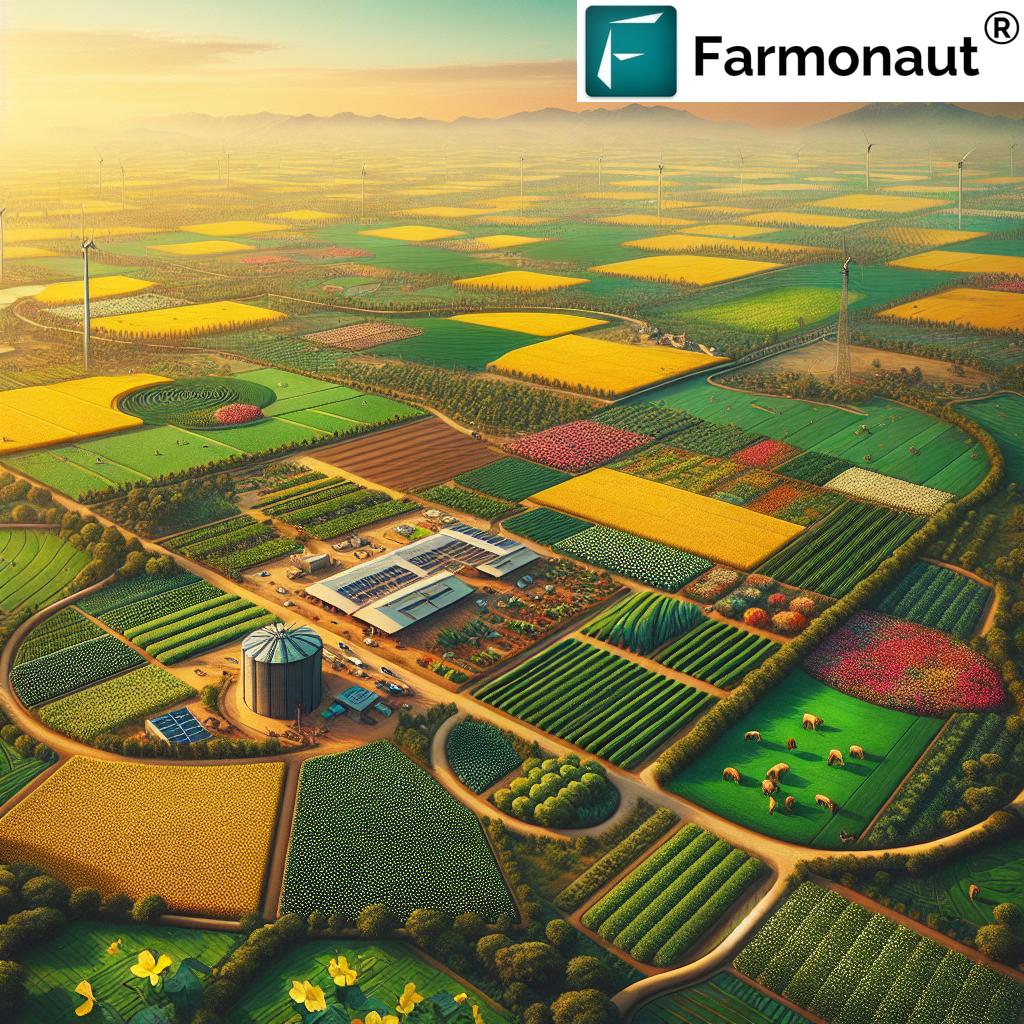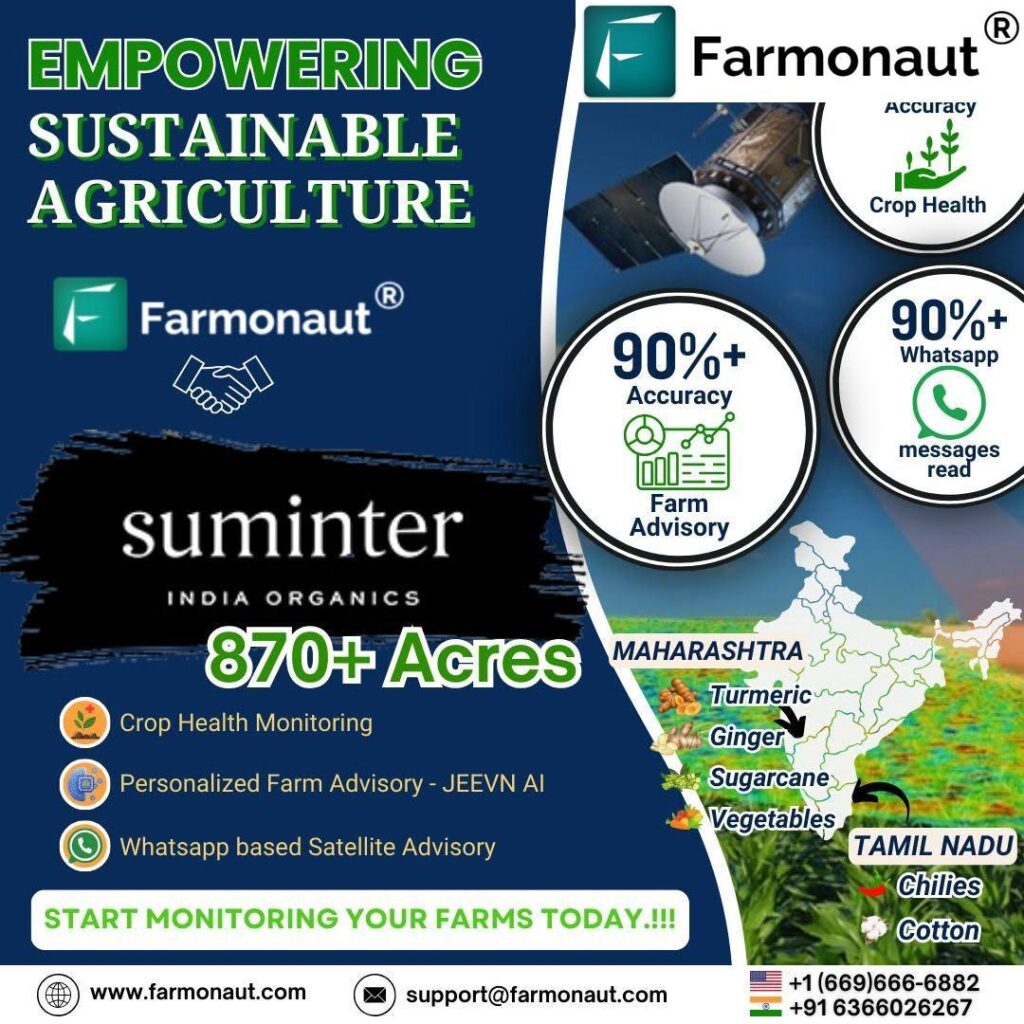- Introduction
- Agriculture’s Contribution to Climate Change in the Philippines
- Estimated Agricultural Emissions by Practice in the Philippines & Sustainable Alternatives (2025)
- Adapting Philippine Agriculture to Climate Change: Strategies for 2025 and Beyond
- Farmonaut: Satellite-Driven Insights for Philippine Agricultural Resilience
- Key Sustainable Practices for Food Security in 2025
- Policy, Community, and Market Solutions Supporting Climate-Adapted Farming
- FAQ: Agriculture, Climate Change, and Philippine Adaptation
- Conclusion of Climate Change and Philippine Agriculture
“Agriculture contributes around 24% of global greenhouse gas emissions, significantly impacting climate change and food security.”
Agriculture Contribution to Climate Change: Adapting PH for a Sustainable 2025
The agriculture contribution to climate change remains a pressing, multifaceted issue for the Philippines in 2025, as the sector is both a victim and a contributor to a warming planet. In a country where farming underpins the livelihood of more than 10 million Filipinos and sustains food security, rising emissions, extreme weather events, and the urgent need for resilience force us to rethink agriculture’s role in present and future environmental health.
How does Philippine agriculture contribute to climate change, and what actions must we take to ensure a stable, climate-smart, and food-secure future by 2025 and beyond?
This in-depth article explores: agricultural emissions and their origins, impacts on rural livelihoods, cutting-edge adaptation strategies, practical sustainable techniques, and how technologies like Farmonaut’s satellite-driven insights support climate action and adaptation. We present a data-driven roadmap for stakeholders, policymakers, and Filipino farmers navigating the complex landscape of agriculture, climate, and food system resilience.
Let’s begin by understanding how deep the roots of agriculture’s climate impact travel—both globally and in the Philippine context.
Agriculture’s Contribution to Climate Change in the Philippines
Agriculture’s contribution to climate change is significant, and the sector’s role as both a source of greenhouse gas (GHG) emissions and a potential sink for carbon shapes global and local climate trajectories. As of 2025:
- Globally, agriculture accounts for approximately 20–25% of all GHG emissions. The main gases are methane (CH4), nitrous oxide (N2O), and carbon dioxide (CO2).
- In the Philippines, agriculture contributes a major portion of national GHG emissions, ranking just behind energy and transport sectors. The unique agricultural practices and climate vulnerabilities of the archipelago amplify the sector’s importance in climate policy.
Key Sources of GHG Emissions in Philippine Agriculture
-
Rice Production and Methane:
- Rice fields, especially traditional flooded paddy systems, are significant sources of CH4.
- Methane is produced by anaerobic decomposition of organic matter in waterlogged soil.
- The Philippines is among the world’s highest per capita consumers and producers of rice, amplifying its role in national emissions.
-
Livestock & Manure Management:
- Cows, buffalo, goats, and other livestock emit methane during digestion (enteric fermentation) and from manure management.
- Livestock emissions in the Philippines have increased due to population growth and changing dietary preferences.
-
Nitrous Oxide from Fertilizers:
- High application rates of synthetic nitrogen fertilizers release N2O, which has a global warming potential 298 times higher than CO2.
- Inefficient fertilizer management further increases emissions.
-
CO2 from Land-Use Change and Deforestation:
- Agricultural expansion into marginal lands and forested areas leads to deforestation—reducing natural carbon sink capacity.
- The Philippines has experienced notable deforestation rates due in part to farming expansion, especially for cash crops and upland rice.
-
Other Emission Sources:
- Soil tillage and burning, inappropriate irrigation methods, and improper residue management further release both CO2 and N2O.

These are not just statistics; they translate into real-world challenges for rural communities. The interconnectedness of agriculture, emissions, and climate change means that the warming process indirectly and directly threatens yields, livelihoods, and national food security.
How Climate Change Impacts Agriculture: The Philippine Vulnerability
- Extreme Weather: Stronger, more frequent typhoons, extended droughts, and irregular rainfall test the resilience of crops and rural communities.
- Soil Health Degradation: Unsustainable practices like excessive tillage and over-irrigation degrade soil structure and carbon sequestration power.
- Rising Temperatures and Shifting Growing Zones: Some crops may become less viable in traditional growing regions, requiring a shift in cropping areas.
- Water Scarcity and Flooding: Erratic rainfall patterns increase the risks of either seasonal water stress or damaging floods.
- Biodiversity Loss: Expansion into ecologically sensitive lands and monoculture systems reduces ecosystem diversity, resilience, and productivity.
The agriculture contribution to climate change in the Philippines is therefore not just an environmental issue but a socio-economic one intertwined with food, health, equity, and national development.
Estimated Agricultural Emissions by Practice in the Philippines & Sustainable Alternatives (2025)
To visualize the role of agricultural practices in GHG emissions, here’s a comparative table outlining conventional methods, their estimated annual emissions, sustainable alternatives, and their emission reduction potential for the year 2025:
Implementing these sustainable practices not only helps reduce emissions but also improves soil health, water retention, and overall system resilience—core priorities for the Philippines as we move toward 2025 and beyond.
Adapting Philippine Agriculture to Climate Change: Strategies for 2025 and Beyond
Given that the sector remains both a victim and a contributor to the warming planet, adapting Philippine agriculture to climate change has become a central tenet of national development strategies. Climate adaptation involves adjusting farming systems, practices, and landscapes to minimize risks, build resilience, and harness new opportunities that arise from evolving climatic realities.
Adaptation is not only about coping; it’s also about transforming. It calls for a multi-pronged approach:
- Addressing Vulnerabilities: Identifying regions, crops, and communities most at risk from climate hazards and prioritizing interventions.
- Promoting Climate-Smart Agriculture (CSA): Integrating methods that sustainably increase productivity, enhance resilience, and reduce GHG emissions where possible.
- Strengthening Institutional Capacities: Bolstering the ability of government, extension workers, and community organizations to provide anticipatory support.
- Using Real-Time Data and Forecasting: Leveraging technology for timely decisions, resource allocation, and disaster preparedness.
1. Diversification and Crop Resilience
Diversified cropping systems and resilient crop varieties are critical. By moving away from single-crop (monoculture) farming and integrating multiple crops—including those tolerant to drought, flood, or salinity—Filipino farmers can buffer income and food supply against volatile weather and climate patterns.
- Stress-tolerant Rice and Maize: Several new breeds withstand water scarcity or flooding, securing the national rice bowl.
- Legume Intercropping: Legumes fix nitrogen, improve soil fertility, and support nutrition security.
- Livestock/Crop Integration: Reduces risks and increases system productivity.
2. Water Management Innovation
Improved irrigation techniques are vital for adapting to both excessive rain and drought conditions. Key approaches include:
- Alternate Wetting and Drying (AWD): This method, especially effective in rice systems, cuts methane emissions nearly by half, saves water, and maintains yields.
- Rainwater Harvesting: Captures storm runoff for dry periods.
- Drip Irrigation & Sprinklers: Delivers water directly to plant roots, reducing waste.
Discover the Large-Scale Farm Management tools
by Farmonaut: Remote monitoring, resource optimization, and analytics for irrigation scheduling and water-saving across Philippine farms.
3. Agroforestry and Reforestation
Integrating trees into agricultural systems—and restoring deforested marginal lands—offers dual benefits:
- Carbon sequestration: Trees capture atmospheric CO2, helping to offset emissions.
- Biodiversity and resilience: Agroforestry improves ecosystem services and creates stable microclimates.
- Land restoration: Reforesting degraded agricultural lands restores long-term productivity.
Farmonaut’s crop, plantation, and forest advisory platform
supports adaptive landscape management and reforestation planning with satellite-based insights.
“By 2025, the Philippines aims to boost agricultural resilience, impacting over 10 million local farmers through sustainable practices.”
4. Sustainable Soil Management
Healthy soil underpins all climate adaptation for farming. Best practices include:
- Conservation Tillage: Minimizes soil disturbance, preventing carbon loss and improving water infiltration.
- Cover Cropping: Protects soil surface and boosts organic carbon stores.
- Organic Fertilizers & Compost: Reduces reliance on synthetic fertilizers, cutting nitrous oxide emissions and enhancing fertility.
5. Early Warning Systems, Information Access & Digital Tools
Climate-smart decisions require timely and precise information. Farmers in the Philippines benefit from:
- Weather and climate forecasts for planting and disaster risk reduction.
- Pest and disease outbreak monitoring (from digital platforms and crowd-sourced data).
- Market intelligence to guide harvest and sales decisions during climate volatility.
Leverage Farmonaut’s fleet and resource management
for efficient logistics and market connection in Philippine agriculture, even during climate-related disruption.
Use Farmonaut’s API and Developer Docs to integrate weather, crop, and soil insights into custom applications for farmers, businesses, or policy agencies.
6. Managing Crop Insurance, Loans, and Traceability
Crop loan and insurance services powered by Farmonaut
enhance financial resilience for Filipino farmers by using satellite data for risk verification—enabling quick, fair, and transparent access to seasonal support.
Blockchain-based agricultural traceability solutions
under Farmonaut ensure credible and transparent supply chains, helping Philippine agriculture align with sustainability and international food standards.
Farmonaut: Satellite-Driven Insights for Philippine Agricultural Resilience
As a technology partner in agricultural climate action, we at Farmonaut provide a suite of affordable satellite-based solutions supporting sustainable agriculture, resource management, and environmental compliance across the Philippines.
Using satellite imagery, AI, and blockchain, Farmonaut empowers Filipino farmers, agribusinesses, and agencies to monitor crop health, predict risks, improve productivity, and track their carbon footprint in near real-time.
Explore Farmonaut’s Carbon Footprinting Features: Accurately track, report, and reduce GHG emissions from Philippine farms, enabling data-driven climate adaptation and sustainable certification for exporters and cooperatives.
- Vegetation Health and Crop Monitoring: Multispectral imaging helps in identifying stress, disease, and irrigation issues across Philippine rice fields, sugarcane, uplands, and other critical regions.
- Weather and Disaster Advisory: Custom alerts for approaching typhoons, drought, or pest outbreaks allow proactive adjustments to cropping calendars and risk mitigation.
- Blockchain Traceability: Food safety, sustainability, and supply chain authenticity—providing a competitive advantage for Philippine products in global markets.
- Resource & Fleet Management: Reduce resource losses, energy consumption, and emissions from logistics through smart fleet tracking and scheduling tools.
- Stakeholder Access: Our data-driven insights are accessible to farmers, businesses, financial institutions, and government agencies—scalable to both smallholders and large agribusinesses.
Ready to accelerate resilience, sustainability, and profitability on your Philippine farm?
Key Sustainable Practices for Food Security in 2025
For Philippine food security in 2025, adopting a holistic approach combining technology, traditional wisdom, and policy innovation is vital.
Here are the pillars of sustainable farming for current and future generations:
A. Soil Organic Carbon & Regenerative Agriculture
Increasing soil organic matter allows farms to store more carbon, retain water, buffer drought, and provide robust yields—even in a changing climate. Regenerative techniques include cover cropping, compost application, and reduction of chemical inputs.
B. Climate-Smart Crop & Livestock Management
- Smart rotation, diversification, and use of stress-tolerant seeds ensure a steady harvest even with unpredictable rainfall and temperatures.
- Improved livestock feed, rotational grazing, and manure management reduce enteric methane and nitrous oxide emissions, building system resilience.
C. Digital Agriculture Technologies
- Decision Support Systems: Apps and platforms (like Farmonaut) guide timing for planting, irrigation, and harvest.
- Remote Sensing: Satellites “see” and predict problems, supporting large and small farms in real time.
- Blockchain for Traceability: Build consumer trust, enable export, and prove sustainability credentials.
D. Participatory & Inclusive Approaches
- Empower Smallholders and Rural Women: Support equitable access to land, extension, financing, and technology.
- Leverage Local Knowledge: Build solutions that combine traditional and scientific climate wisdom.
E. Informed Market Access and Policy Support
- Climate-aligned agricultural subsidies and insurance sustain farm income during climate anomalies.
- Promotion of sustainable goods: Strengthen domestic and export markets for products farmed using climate-resilient methods.
Policy, Community, and Market Solutions Supporting Climate-Adapted Farming
Aligning policy, community action, and market incentives is crucial for scaling resilient and sustainable Philippine agriculture that meets climate and food security goals by 2025.
Key Recommendations:
- Strengthen extension networks: Ensure farmers access up-to-date information and technical support for climate adaptation strategies.
- Incentivize sustainable practices: Promote the shift to low-emission and regenerative techniques via grants or tax breaks.
- Invest in climate-resilient infrastructure: Support for water storage, irrigation, reforestation, and rural roads reinforces resilience.
- Support inclusive finance: Expand concessional loans and insurance linked to climate-smart practices.
- Market mechanisms: Encourage companies, co-ops, and value chains to value sustainable production in pricing and purchasing agreements.
- Enable climate transparency: Standardize carbon footprinting and traceability.
Traceability tools by Farmonaut offer secure, verifiable supply chains, building overseas market trust for Filipino exports grown with sustainable, climate-conscious methods.
FAQ: Agriculture, Climate Change, and Philippine Adaptation
Q1: Why does agriculture contribute to climate change in the Philippines?
Agriculture emits greenhouse gases through rice paddy methane, livestock digestion, synthetic fertilizer use, deforestation, improper soil and irrigation practices. High dependency on rice and land-use change amplify the sector’s share of emissions.
Q2: What is the consequence if we don’t adapt Philippine agriculture to climate change?
Risks include lower yields, more frequent crop failure, eroding income for over 10 million rural Filipinos, food insecurity, and loss of biodiversity and arable land.
Q3: How can Filipino farms reduce emissions and become more resilient in 2025?
By shifting to diversified cropping, adopting climate-resilient crop varieties, utilizing sustainable water and soil management practices, promoting agroforestry, reducing synthetic fertilizer use, and embracing digital technologies for information and forecasting.
Q4: How does Farmonaut support climate action in Philippine agriculture?
We offer satellite-based monitoring, AI-driven advisories, environmental impact tracking, blockchain traceability, and mobile/web applications to give timely, actionable insights for sustainable food and resource production across the Philippines.
Q5: Which crops are most at risk due to climate change in the Philippines?
Rice, corn, coconut, and sugarcane are highly vulnerable due to their exposure to typhoon, drought, and flood risks. Monoculture systems are generally less resilient than diversified farming.
Q6: What are the financial tools for climate-adaptive agriculture in the Philippines?
Crop insurance, satellite-based loan verification, grant programs, and incentive schemes support risk reduction and development investments by Filipino farmers in climate-smart practices.
Conclusion of Climate Change and Philippine Agriculture
The agriculture contribution to climate change places both immense responsibility and unique opportunity on the shoulders of the Philippines as a top agricultural nation. With climate change directly impacting food security, rural livelihoods, and economic stability, adapting Philippine agriculture to climate change becomes a non-negotiable pillar of national survival and progress.
- Mitigating GHG emissions from rice, livestock, fertilizer use, and land conversion through sustainable methods is critical to delivering co-benefits for climate and food security.
- Embracing technological, ecological, and policy innovation allows us to buffer agricultural systems against evolving climate realities—ensuring that rural Filipinos remain food secure, economically empowered, and environmentally responsible.
- We at Farmonaut are dedicated to equipping Philippine farms, agribusinesses, and agencies with actionable, data-driven insights to meet the dual challenge of productivity and sustainability.
The journey to a climate-resilient agricultural future is complex, requiring unified support from farmers, policymakers, businesses, and society at large. By taking critical steps now, the Philippines can safeguard its harvest, empower its people, and become a model for sustainable, climate-smart agriculture in Southeast Asia and beyond.
Together, let us transform the conclusion of climate change in the Philippines from a story of adversity into one of resilience, innovation, and hope.













